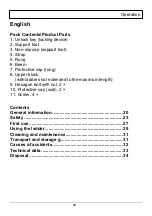
Operation
32
objects or dirt.
− Only ever store the ladder where it cannot be considered a tripping hazard or
obstacle.
− Only ever store the ladder where it is protected against free access and so
cannot be used for criminal purposes.
− In the event of the permanent use of the ladder and the associated free access
(e.g. on a scaffolding), always secure it against use by unauthorised persons,
so that access by unauthorised persons (e.g.
− playing children) can be prevented.
− Slide the ladder completely back together after every use and secure it using
the belt 4 in order to prevent it from extending unexpectedly.
− Store the ladder in a dry place.
− Store the ladder out of the reach of children.
− Make sure that children do not handle the ladder unsupervised.
− Store the ladder out of direct sunlight.
− Store in a closed and upright position.
Causes of accidents
The following non-exhaustive list of risk names typical dangers and examples of
common causes of accidents when using ladders.
Consider the risks mentioned when handling the ladder as the basis of safe
working to prevent accidents.
a) Loss of stability
1. Incorrect positioning of the ladder (e.g. incorrect setup angle of lean-to ladders
or incomplete opening of stepladders);
2. Slipping of the bottom end of the ladder outwards, e.g. away from the wall
against which the ladder is leaning;
3. Lateral sliding of the ladder, falling to the side and tipping of the top tread (e.g.
due to leaning too far sideways or insufficient hold on the top tread);
4. Poor condition of the ladder (missing or damaged rubber caps on the stand);
5. Climbing off an unsecured ladder at height;
6. Unsuitable surface at the ladder’s setup location (e.g. unstable, soft floor,
inclined floor, slippery surfaces or dirty, solid surfaces);
7. Adverse weather conditions (e.g. wind);
8. Collisions with a ladder, e.g. by vehicles or doors;
9. Incorrect ladder selection (e.g. ladder too short, inappropriate use).







































